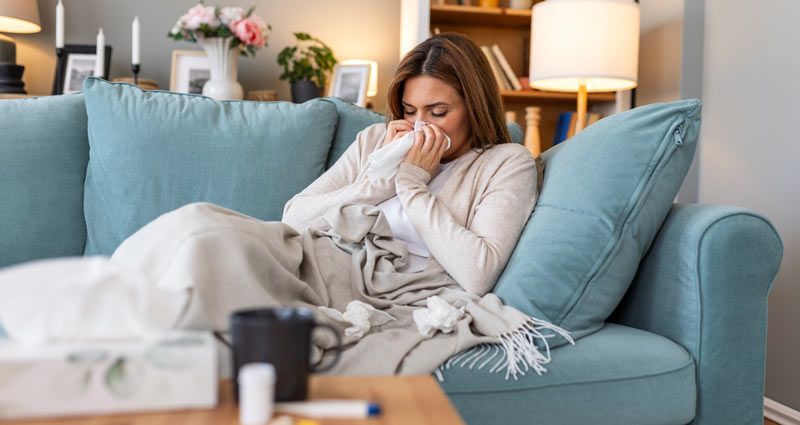Breathe Cleaner, Healthier Air at Home
The air inside your home may seem clean, but is it really? From allergens to harmful chemicals, the air we breathe indoors often contains hidden pollutants that can impact our health. Discover and learn about your home's top ten air contaminants and how a high-quality air filter can protect your family.
-Dr. Dana Cohen

Is Your Indoor Air Quality at Risk? Discover the Hidden Contaminants and How to Protect Your Family
What's in Your Air? The Top Ten Indoor Air Contaminants
Poor indoor air quality can lead to allergies, asthma, and long-term health risks. Below are the most common contaminants polluting your home's air:
Dust Mites
Dust mites contribute to unhealthy indoor air by producing allergens through their waste, which can become airborne and trigger allergic reactions in sensitive individuals. When inhaled, these microscopic allergens can exacerbate respiratory problems, including asthma, leading to symptoms such as coughing and wheezing. The presence of dust mites can lead to inflammation in the respiratory tract, making it difficult for individuals to breathe comfortably.
High humidity levels in homes can further promote dust mite proliferation, creating a cycle that worsens air quality. Dust mites accumulate in bedding, carpets, and upholstered furniture, causing these areas to become hotspots for allergen buildup. Consequently, the combination of allergens, respiratory irritation, and humidity issues contributes to an unhealthy living environment.
Pollen
Pollen can make the air in your home unhealthy by triggering allergic reactions in sensitive individuals, leading to symptoms like sneezing, nasal congestion, and itchy eyes. When pollen grains become airborne and enter your home, they can irritate the respiratory system, exacerbating conditions like asthma and resulting in difficulty breathing. Pollen can accumulate on indoor surfaces, so allergens can linger in your living space even after the outdoor pollen count decreases.
Pollen in the air can contribute to indoor air quality issues, increasing the overall allergen load in the home. During certain seasons, particularly spring, trees, grasses, and flowers release significant amounts of pollen, making it difficult for allergy sufferers to find relief indoors. As a result, homes can become environments where allergic reactions are aggravated, impacting the health and comfort of residents.
Pet Dander
Pet dander can significantly impact indoor air quality by releasing tiny, lightweight flakes of skin that can quickly become airborne and trigger allergic reactions in sensitive individuals. These particles can lead to various symptoms, such as sneezing, itchy eyes, and respiratory issues, particularly for those with asthma or allergies. As pet dander accumulates on surfaces like furniture, carpets, and bedding, it creates environments where allergens thrive, making achieving a clean and healthy living space challenging.
Pet dander can mix with other airborne allergens, such as dust mites and pollen, compounding health risks and exacerbating allergy symptoms. Dander can also contribute to increased indoor air pollutants, which may lead to ongoing discomfort for residents. Consequently, homes with pets may require more intensive cleaning and air quality management to minimize the adverse effects of pet dander on health.
Mold Spores
Mold spores contribute to unhealthy indoor air by releasing airborne allergens that can trigger respiratory issues and allergic reactions in sensitive individuals. When these spores become inhaled, they can cause symptoms such as sneezing, coughing, and eye irritation, particularly for those with pre-existing asthma or allergies. Mold thrives in damp, humid environments, meaning that high moisture levels in a home can increase mold spore concentrations in the air.
Certain types of mold can produce mycotoxins, which are toxic substances that can lead to more severe health problems, including headaches, fatigue, and respiratory infections. Even after removing the visible mold, spores can remain in the air and persist on surfaces, presenting ongoing health risks. Consequently, homes with mold growth can become significant sources of indoor air pollution, affecting the health and well-being of their occupants.
Volatile Organic Compounds (VOCs)
Volatile Organic Compounds (VOCs) can significantly degrade indoor air quality by releasing harmful chemicals into the air, originating from various sources such as paints, cleaning products, and building materials. When these compounds evaporate at room temperature, they create a hazardous environment that can lead to various health issues, including headaches, dizziness, and respiratory problems. Prolonged exposure to VOCs can exacerbate asthma and other respiratory conditions, particularly in sensitive individuals or those with pre-existing health concerns.
Some VOCs are classified as carcinogens, meaning they can increase the risk of cancer with long-term exposure. Even low levels of VOCs can contribute to poor indoor air quality, as they can combine with other pollutants to create harmful effects. Consequently, homes that lack proper ventilation or are filled with products containing VOCs can pose significant health risks to their occupants.
Tobacco Smoke
Tobacco smoke makes the air in your home unhealthy by releasing a complex mixture of harmful chemicals, including nicotine, tar, and formaldehyde, which can linger in the environment long after smoking has ceased. When tobacco is smoked, thousands of toxic substances are produced, many of which are classified as carcinogens and can pose serious health risks to anyone exposed. Inhaling secondhand smoke can lead to respiratory problems, increased risk of heart disease, and a range of other health issues for nonsmokers, particularly children and pregnant women. The fine particulate matter in tobacco smoke can penetrate deep into the lungs, exacerbating conditions like asthma and bronchitis.
Tobacco smoke can settle on surfaces throughout the home, leading to "thirdhand smoke," which can persist and continue to emit harmful toxins even after the smoke has cleared. As a result, homes with smokers are often environments rife with pollutants, significantly endangering the health and well-being of all occupants.
Carbon Monoxide
Carbon monoxide (CO) makes the air in your home unhealthy by being a colorless, odorless gas that can interfere with the body's ability to transport oxygen. When inhaled, CO binds to hemoglobin in red blood cells more effectively than oxygen does, which can lead to oxygen deprivation in vital organs, potentially resulting in serious health effects or even death. Symptoms of carbon monoxide poisoning can include headaches, dizziness, shortness of breath, confusion, and fatigue, which are often mistaken for other illnesses.
Sources of carbon monoxide in the home include malfunctioning gas appliances, fireplaces, and vehicles running in enclosed spaces. Even low levels of exposure can be dangerous over time, causing cumulative health effects that can compromise overall well-being. Therefore, having proper ventilation and functioning carbon monoxide detectors is crucial to ensure a safe indoor environment and protect residents from this unseen threat.
Bacteria and Viruses
Bacteria and viruses can make the air in your home unhealthy by becoming airborne and leading to the spread of infectious diseases. When someone in the household coughs or sneezes, tiny droplets containing pathogens can linger in the air, allowing viruses and bacteria to be inhaled by others. This can cause respiratory infections, flu, and other illnesses, particularly in individuals with weakened immune systems. Certain bacteria, like those associated with mold or damp conditions, can release toxins into the air, exacerbating allergies and respiratory issues.
Surfaces contaminated with bacteria and viruses can contribute to the overall pollution of indoor air, as these pathogens can be transferred to the hands and then spread throughout the home. Ensuring good ventilation, maintaining cleanliness, and employing air purification methods are essential strategies to reduce the presence of these harmful microorganisms in indoor environments.
Airborne Dust
Airborne dust can make the air in your home unhealthy by carrying an array of particulate matter that can trigger allergic reactions and respiratory problems. This dust often contains a mixture of allergens such as pollen, mold spores, pet dander, and dust mite waste, which can aggravate conditions like asthma and allergies. These particles can easily be inhaled when they become airborne, leading to symptoms such as sneezing, coughing, and difficulty breathing.
Airborne dust can absorb and harbor pollutants like chemicals from household cleaners, smoke, and volatile organic compounds, further compromising indoor air quality. Dust accumulation on surfaces can also contribute to the growth of bacteria and fungi, adding to the health risks associated with poor air quality. Regular cleaning and proper ventilation are essential to minimize airborne dust and maintain a healthier indoor environment.
Cooking Fumes
Cooking fumes can make the air in your home unhealthy by releasing various pollutants and particulate matter into the indoor environment. When food is heated, especially at high temperatures, it can produce smoke, gases, and volatile organic compounds (VOCs), which can irritate the respiratory system. These fumes often contain substances such as carbon monoxide, nitrogen dioxide, and polycyclic aromatic hydrocarbons (PAHs), which can pose health risks, particularly for individuals with asthma or other respiratory conditions.
Cooking methods like frying and grilling can create fine particulate matter that lingers in the air and can be inhaled, contributing to long-term health issues. Poor ventilation during cooking can exacerbate the accumulation of these harmful substances, leading to increasingly unhealthy indoor air quality. To mitigate these effects, using exhaust fans, opening windows, and ensuring proper kitchen ventilation can help maintain a healthier atmosphere while cooking.
How Does a High-Quality Air Filter Protect Your Home?
A top-tier air filter does more than just clear the air. It actively captures and eliminates harmful impurities, ensuring your breath is cleaner and healthier. Here's how it works:
- Particle Capture - Advanced filters trap airborne particles as small as 0.3 microns, including allergens, pet dander, and mold spores.
- Odor Neutralization - Activated carbon filters absorb and neutralize odors from cooking, smoke, or chemicals.
- Round-the-Clock Protection - A quality air filter keeps your indoor environment safe and fresh by circulating and cleaning the air continuously.
Filters with a high MERV rating or HEPA certification are particularly effective. Many models are also designed with energy efficiency in mind, ensuring cleaner air without spiking electricity bills.
Take Control of Your Home's Air Quality
A high-quality air filter protects your home from common pollutants by capturing and trapping harmful particles before they circulate indoors. It effectively removes allergens such as dust, pollen, and pet dander, reducing occupants' risk of allergic reactions and respiratory issues. Additionally, these filters can capture mold spores, thus preventing their growth and propagation within the home environment. High-quality air filters are also designed to trap volatile organic compounds (VOCs), which are harmful gases emitted from paints, cleaning products, and other household materials. They can help mitigate the effects of airborne bacteria and viruses, reducing the likelihood of illness and infection among household members. High-quality air filters contribute to a healthier and more comfortable living space by maintaining good air quality and filtering out these pollutants.
Breathe easier today and make the smart choice for your home.


















